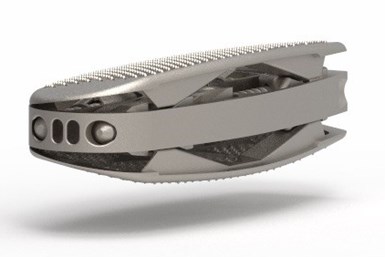Tsunami Medical Uses Additive Manufacturing for Innovating Surgical Solutions
The Tsunami Medical team is working to improve implant design and challenging conventional manufacturing techniques of the past.
Share
Read Next

Tsunami Medical Giannutri direct lateral expandable cage
Tsunami Medical is continuing to innovate spinal technology solutions using GE Additive’s direct metal laser melting (DMLM) additive technology. Since the beginning of 2021, the company has launched nine 3D-printed titanium spinal-fusion implants as well as a pedicle screw and rod system.
The companys says it now offers a full product portfolio for spinal fusion, including four cages featuring built-in additional fixation features, four expandable ones and the first 3D-printed screw-and-rod system in the world, both for open and MIS procedures. This second generation of implants is said to incorporate many of the design and manufacturing advantages which can only be offered by metal additive manufacturing (AM) technology.
The new intervertebral (or interbody) bone ingrowth cages replace the vertebral disc to facilitate a bony fusion of the vertebral segment, and retain or restore balance and stability of the vertebral column, the company says. Because there are several ways to approach the affected vertebral segment, the company said it designed cages for each specific surgical approach, designing specific instruments and tools, and manufacturing them using AM based on proven Bone InGrowth technology.
The new cages are said to be an improvement upon previous versions which were made of machined titanium bars and later polyether ether ketone (PEEK). Using laser- and EBM-based additive technologies, the company says it is possible to produce a trabecular surface, which is similar to the natural bone’s structure and optimal for bone ingrowth. The net structure design is based on clinical experience and scientific research, which indicate that the ideal pore size for promoting bone ingrowth is between 500 and 700 microns, which the company says is only possible using AM.
According to the company, this net structure, in combination with the geometrical design of Tsunami Medical’s cage options, offers an elasticity of the implant at least equivalent to PEEK and very close to the micro-elasticity modulus of natural bone. It is said to be an essential requirement for facilitating rapid ingrowth of bone tissue and building the required bone bridge between the vertebral bodies.
Related Content
-
Partners Improve Wheelchair Seats, Cushions Using 3D Printed Programmable Foam
The 3D printed programmable foam is said to enhance orthopedic seats and cushions, offering improved comfort and reliability for users.
-
GE Additive, Orchid Collaborate on 3D Printing Orthopedic Joint Implants
The agreement bolsters the use of additive manufacturing in the medical implants sector with the development of electron beam melting solutions.
-
More Affordable Suture Anchors 3D Printed from PEKK: The Cool Parts Show #60
Selective laser sintering (SLS) of polyether ketone ketone (PEKK) is being used to produce medical implants that are more cost effective and perform better than their conventional counterparts. We highlight fasteners known as suture anchors in this episode of The Cool Parts Show.








.png;maxWidth=300;quality=90)





